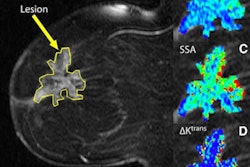MRI's strong magnet pushes fluid that circulates in the inner ear's balance center to cause vertigo or the sensation of free-falling in some patients undergoing scans, say researchers from Johns Hopkins University in a study published online September 22 in Current Biology.
The condition is more prevalent with newer, high-strength MRI systems, and could call into question results of functional MRI (fMRI) studies designed to detect brain and mind activities under various circumstances, according to the authors. The study was led by Dale C. Roberts, a senior research systems engineer in the university's department of neurology.
To determine the mechanism behind MRI-induced vertigo, the group evaluated 10 volunteers with healthy labyrinths, the inner tubelike structures in the ears that control balance. The researchers also scanned two volunteers who lacked labyrinthine function.
Roberts and colleagues tracked vertigo by the volunteers' reports and by watching a type of involuntary eye movement that reflects the brain's detection of motion. Because visual clues can help suppress involuntary eye movement, the experiments were conducted in the dark.
Night vision cameras showed that the healthy volunteers all had involuntary eye movement in the MRI scanner, but the two subjects with no labyrinthine function experienced no involuntary eye movement, suggesting that the labyrinth plays a key role in MRI-related vertigo.
The researchers also tested MRI systems of different magnet strengths over various periods of time on the healthy volunteers. In addition, they monitored the volunteers' involuntary eye movement as the subjects moved in and out of the MRI bores to gauge the impact of motion or direction of magnetic field on their centers of balance.
Roberts and colleagues concluded that higher magnetic field strengths caused significantly faster involuntary eye movement, which continued throughout the time volunteers spent in the machine, regardless of the length of the experiment.
The direction of the eye movements also changed based on which way the volunteers entered the bores, suggesting that the effect on the labyrinth was directionally sensitive.
The findings have implications for functional MRI studies, which measure brain activity by imaging blood flow in the brain as subjects perform tasks, the authors noted. The MRI scanner itself could cause previously unnoticed brain activity related to movement and balance, potentially affecting MRI results.
"We've shown that even when you think there's nothing happening in the brain while volunteers are in the scanner, there's actually a lot happening because MRI itself is causing some effect," according to Roberts. "These effects must be taken into account in the way we interpret functional imaging."
The group added that MRI's strong magnetic field could eventually be used to stimulate the labyrinth to diagnose and treat inner ear and balance disorders in a more comfortable and noninvasive way than some current methods.


.fFmgij6Hin.png?auto=compress%2Cformat&fit=crop&h=100&q=70&w=100)





.fFmgij6Hin.png?auto=compress%2Cformat&fit=crop&h=167&q=70&w=250)











